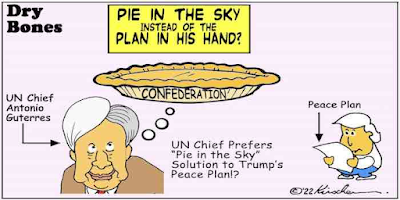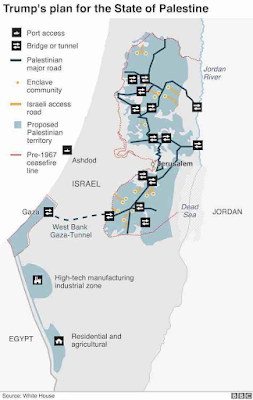United Nations (UN) Secretary-General Antonio Guterres has had an epiphany—just four days after declaring on February 8th that there was no plan B to replace the UN-endorsed Israel-PLO two-state solution: Creating a second Arab State – in addition to Jordan—in the territory comprised in the 1922 League of Nations Mandate for Palestine.
On February 12th Guterres spoke positively of a new grassroots Plan B - “The Holy Land Confederation” - creating an Israeli-Palestinian confederation - after meeting with its authors in New York.
Creation of The Holy Land Confederation involves:
- the Palestine Liberation Organisation leadership (PLO) and the Israeli government negotiating a confederal peace agreement within one year on the future borders of the two States and on a future confederation - including its potential evolution and further stages of liberalization over another four years
- If no confederal agreement is reached within one year then negotiations for a Peace Agreement will center on the two state solution only.
“No formal confederations exist today, and the few states that call themselves a “confederation” are in fact federations” (p.91)
Yet this pie in the sky, vague and nebulous confederation proposal has been deemed significant enough for Guterres to give it his endorsement.
Guterres’ spokesman Stephane Dujarric said after the February 12th meeting:
“The secretary-general received [former Israeli justice minister] Yossi Beilin and [former Palestinian negotiator] Hiba Husseini, who presented him with their report on the ‘Holy Land Confederation’ process ... He thanked them for their useful contribution to try and achieve a lasting solution to the conflict,”
The meeting with Guterres lasted just 40 minutes and included four of Guterres’ advisers. Guterres reportedly said the plan could perhaps help revive the peace process - expressing regret at the absence of negotiations.
Beilin reportedly said he asked Guterres if the confederation plan could be included in Guterres’ talking points with leaders in the region and if Guterres could help the group use the UN platform for debates and discourse on the confederation:
“He [Guterres] promised that in his talks with his interlocutors, as he said, he will raise this option of a confederation,” Beilin said, adding that separately, “for the first time after many years, [Guterres said] he can have a dialogue with the Israeli government.”
There is another – and far better - alternative plan waiting in the wings to revive the peace process and get negotiations started: The Trump-Israel-PLO-Jordan Initiative
- Israel and the PLO negotiate for the creation of a two-state solution on the basis of President Trump’s 2020 Peace Plan – and in default of their agreeing to do so or failing to reach agreement
- Israel and Jordan negotiate to redraw their current agreed international boundary designated under Clause 3(2) of the 1994 Jordan-Israel peace Treaty – based on Trump’s Plan
- 100% of Gaza and about 70% of Judea and Samaria (West Bank) containing 95% of its Arab population will in either scenario be internationally-recognised as being under Arab sovereignty and control.
- No Arab or Jew will have to leave his current home.
The uncertainties and five year time frame involved in negotiations to establish The Holy Land Confederation stand in strong contrast to the immediate results that negotiations based on The Trump-Israel-PLO-Jordan Initiative could yield within months.
Guterres will be doing world peace a disservice if he ignores endorsing The Israel-PLO-Jordan Trump Initiative after endorsing The Holy Land Confederation proposal.
Guterres’ welcome change of course opens up a new horizon for finally resolving the 100 years old Arab-Jewish conflict.
Author’s note: The cartoon—commissioned exclusively for this article—is by Yaakov Kirschen aka “Dry Bones”- one of Israel’s foremost political and social commentators—whose cartoons have graced the columns of Israeli and international media publications for decades.



No comments:
Post a Comment